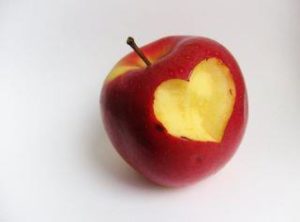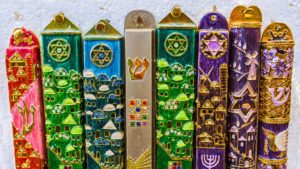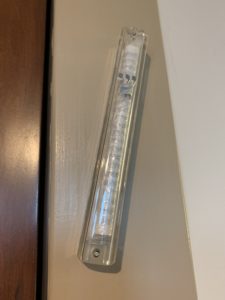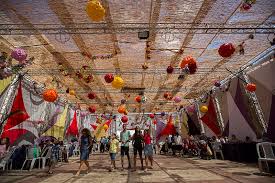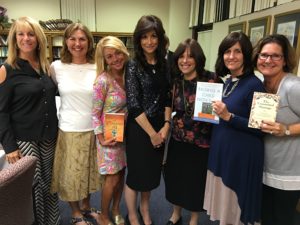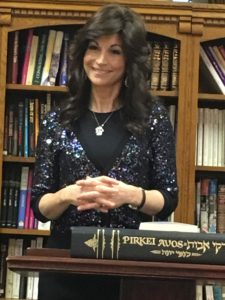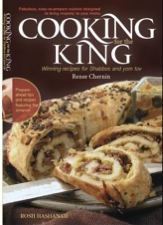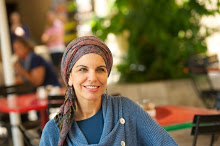Rosh Hashanah Feast Serves Up Symbolism
Jewish holidays like Rosh Hashanah are filled with rituals, tradition, and symbolism that nourish the body and the soul through food, and we’re not talking about brisket and matzo ball soup that always earn a spot on the menu.
The rich and abundant foods served on Rosh Hashanah are called simanim, which means “signs†or†indicators.†Like the special foods we eat at a Passover seder, simanim give us a taste of Jewish wisdom by directing us to improve ourselves and return to a life with more purpose and meaning. This idea of teshuva is what the High Holidays is all about, little did we know it tasted so good, with a dash of Yiddish pun.
So, let’s dig in! Continue reading
The Sounding of the Shofar Awakens The Soul
One of the highlights of the high holidays is to hear the shofar.
The shofar, a hollowed out ram’s horn, is the most ancient musical instrument used throughout history as a rallying call to bring people together. In ancient Israel, the shofar announced the New Moon (Rosh Chodesh), was blown in the desert as a battle cry to declare war and celebrate victories, was blasted on Mount Sinai when the Jewish people received the Ten Commandments, and the Hebrew tribe Levites of the Holy Temple played the shofar as one of their musical instruments.
In modern times, the shofar most commonly blown like a trumpet to signal the coming of the New Year—Rosh Hashanah—and to awaken our souls and bring us closer to God.
Traditionally, the most common place to hear the shofar is in synagogue, but this year because of covid19, many of us will hear the blast of the shofar outdoors, in a park, on a neighborhood street, in our backyard, or virtually on a computer. Continue reading
MyZuzah Wants To Bless Every Jewish Home in the World
Our homes are our castles–even more than that– our homes are our sanctuaries and the foundation of our Jewish lives.
Some of our fondest childhood memories take place in the home…lighting the Hanukkah menorah and displaying it in the window, gathering together for Shabbat, building a sukkah in our backyard are just a few ways build our Jewish identity for generations to come. Continue reading
Rosh Hashanah Mezuzzah Symbolizes New Beginnings
When I think of the High Holidays, many traditional symbols come to mind—
the sound of the shofar, an instrument made of a ram’s horn that signals the awakening of the Jewish people. The short and long blasts of the shofar—tekia, sh’varim, teruah, and tekia gedolah—summon us to come together and renew our relationship with each other, ourselves, and, of course Hashem. Crisp apples dipped in honey tempt our taste buds for a sweet new year, while we try a new fruit to symbolize gratefulness for being alive and allowing us to enjoy all the delicious fruit of the creator. A favorite fruit on this holiday is the pomegranate for its biblical significance—the Land of Israel is known for its pomegranates and is one of the “seven species†for its abundant seeds (613 to be exact) associated with fertility and good deeds, specifically the 613 mitzvot in the Torah. Here’s a good way to seed a pomegrante!
Challah is eaten all year round on Shabbat, but on the High Holidays the braided loaf is made into a round shape that represents the crown of a king for it was on Rosh Hashanah, the birthday of mankind, the sixth day of creation, that Hashem was coronated as King of the Jewish people. Another symbolic ritual during the 10 Days of Awe is tashlich, meaning “casting off†our sins of the previous year by tossing pieces of bread or another food into a natural body of flowing water. Beautiful melodic prayers such as the Armaic words of Kol Nidre, meaning “all vows,” and Avenu Malkenu, “Our Father Our King,” stir our emotions as we dig deep into our soul, asking and granting forgiveness of others and ourselves to release burdens we carry and start anew.
This year, for the first time, another Jewish symbol was added to the High Holidays for my family. The mezuzzah that we hung in my son’s new apartment on the Sunday before Rosh Hashanah. Continue reading
Sukkot Celebrates Bountiful Harvest with Family, Friends, Food & Fun
The week-long festival of Sukkot, the Hebrew word for “booths,†begins when the sun goes down tomorrow night (September 23-30), and is considered one of the happiest times in the Jewish calendar. When else are we commanded to build a hut-like structure, called a sukkah, in our backyard, decorate it with fresh fruit, gourds and other Judaica ornaments, and get to eat our meals alfresco and even sleep under roofs of branches open to the stars? Continue reading
My High Holiday Hike With Hashem
During the High Holidays, the 10-day period between Rosh Hashanah and Yom Kippur, more Jews fill the pews than any other time of year. Known as The Days of Awe, we push ourselves to do some serious soul searching. Â We dig deep during this time of teshuva, a Hebrew word that translates literally as “return” and describes the return to God and with our fellow human beings as we ask (and grant) forgiveness and strive to better ourselves, our souls.
We walk or drive to our places of worship, sometimes having to park miles away and take a shuttle because the parking lot is so packed. We don our finest holiday clothes, schmooze with friends, listen to the loud blasts of the shofar, recite special prayers, and read from the Torah. The rabbis wear white robes adorned with silver and gold to symbolize royalty and the annual coronation of God as King of the Jewish people.
On this Rosh Hashanah, I celebrated the birthday of the Jewish people at Nusach Hari B’nai Zion because I feel particularly close to the Orthodox rabbis there, and I gain a lot of insight from the learner’s service afterwards; On Kol Nidre, the eve of Yom Kippur, I helped collect tzedakah, or charity, at Congregation Shaare Emeth, a reformed temple where my kids made their bar and bat mitzvah. When Cantor Seth belts out the Jewish prayer Avenu Milkenu,“Our Father Our King,†his beautiful voice fills the sanctuary. Every year, the rabbis deliver sermons of various themes, their words profound and personal and make me feel proud to be a Jew.
This year, something special happened to me in between Rosh Hashanah and Yom Kippur services, and it took place somewhere without stained-glass windows or a Holy Ark. There was no dress code or crowd of people, either. You see, Hashem a Hebrew term for God, came to me while I was lost in the woods, all alone, wearing gym shorts and a t-shirt, and covered with sweat and bug spray.
I call this story my “A-HAshem†moment.
Three Gifts I Learned at Rosh Hashanah
Rosh Hashanah, translated in Hebrew as “head of the year,†is a time to let go. As a new Empty Nester, letting go seems to be the theme of everything these days. We let go of our mistakes from the previous year, let go of shame we may be feeling, let go of sorrow for hurting someone, and, of course, ask for their forgiveness.
The Jewish New Year is also a celebrated time for new beginnings…a new school year, a new relationship with others, a new commitment to better ourselves, and a reawakening of Judaism and the Almighty.
Practicing Gratitude on Rosh Hashanah
Being grateful is a central theme of Judaism, especially on Rosh Hashanah when we take inventory of all the blessings in our lives. We turn to God and offer thanks for our abundance, even during the darkest times.
In one of the most recognized and quoted texts in Jewish thought, Pirke Avot (written around the year 200 CE), we learn “Who is rich? Those who rejoice in their own portion.â€
Rosh Hashanah Soul Searching–Will You Be Ready?
On this Rosh Hashanah, don’t just show up. Be ready!
The Jewish New Year, Rosh Hashanah, is unlike the celebration of the secular New Year because the resolutions we make are not only to ourselves but to God. Whereas a typical New Year’s resolution on the first of January might be to go the gym and lose a few pounds, the Jewish New Year is a time to really work up a sweat and ask God as our personal trainer to help make us stronger and a better person in the year ahead.
Join Our Girl’s Night Out! Israeli Cooking Demo Feeds The Soul
Whether you’re looking for interesting new recipes for Rosh Hashanah or just want a fun Girl’s Night Out, join our Israeli cooking demo and tasting on September 10, 7-9 p.m., with Renee Chernin, an international speaker and author of the widely acclaimed Cooking for the King, Rosh Hashanah Edition.
Presented by The Jewish Women’s Society, this kosher food fest, called “Success in Elul,” is open to everyone in the community. Chernin promises to feed the soul with recipes like the sweet and crunchy Shana Tova salad, which she describes as a “one jewel toned salad that has become a holiday tradition and is so beautiful it can be the centerpiece for your Yom Tov table.”Â
Continue reading
